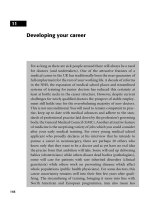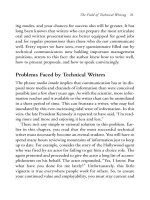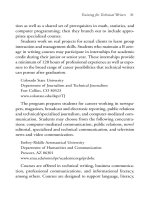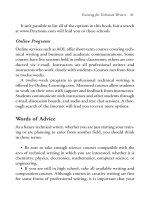martain scorseses film career
Bạn đang xem bản rút gọn của tài liệu. Xem và tải ngay bản đầy đủ của tài liệu tại đây (40.27 KB, 2 trang )
Martin Scorsese has been called a "directing god by movie critic, Roger Ebert. He has been called
the "most influential and best director of their time" by fellow director, George Lucas. Director
Martin Scorsese has been an influential director for the past twenty years. Scorsese is in the 60's
class of directors that include, Francis Coppola, George Lucas, Brian De Palma, and Steven
Spielberg. Scorsese is associated with this class of artists because his movies have changed the
film industry of America.
The impact of Scorsese can be shown in a number of ways. His style of directing, the films that he
has made, and also the relationships that he has made in the film industry. The first is his
directorial skills, which are second to none. Scorsese doesn't just set up the scene, he paints
images and feelings into the viewers mind by using camera shots that have become his trademark.
Another reason for his great success is the films that he directs and the actors he uses. He also has
picked certain actors (notable Robert DeNiro) to portray his characters. In the ruthless business of
Hollywood, Scorsese has built loyalties to actor, screen writes and editors who he uses in many of
his films.
Martin Scorsese was born on November 17, 1942 in the East Side of Queens, New York, in an
area called "Little Italy." Little Italy consisted of about ten blocks, but as Scorsese talks about it,
each block had there own "boundaries" where everyone stayed. He grew up on Elizabeth Street,
and he spent much of his time in the movie theater. As he was growing up, he had strong Catholic
roots in his Italian heritage that would later influence such films as, Mean Streets and Goodfellas.
Growing up, Scorsese was not thinking of becoming a director, but rather a priest, and even went
to college to become a priest. He ended up dropping out his first semester, and then attending New
York University film school. At NYU, he made several student films that received honors from
the school. One short film called, Who's That Knocking At My Door starred a young Harvey
Keitel. Scorsese financed and made this film entirely by himself. He went on to making
documentaries, and then was hired by producer Roger Corman and directed a low budget film,
Boxcar Bertha. This opened the door to Hollywood productions. In 1973, he made his first New
York set film, Mean Streets which was a powerful portrayal of life in "Little Italy." This film
showed the talent he possessed as well as started a relationship with actor Robert DeNiro who
would star in eight more Scorsese films. Scorsese's next film was, Alice Doesn't Live Here
Anymore in 1975 which was a big popular success. The following year, he made one of his best
films, Taxi Driver, a disturbing story of a loner cab driver who goes on a mission to clean up the
streets. The film received worldwide recognition, and Scorsese moved into a place as an elite
director.
Scorsese moved on and made the musical New York, New York that was a tribute to the 40's and
50's musicals that Scorsese grew up enjoying. Scorsese's next work was a documentary, The Last
Waltz in 1978 that is considered to be the best concert movie ever made. After changing pace,
Scorsese returned to his roots, and directed one of his greatest works, Raging Bull. This is a story
of boxier Jake LaMotta portrayed by Robert DeNiro. Scorsese received a nomination for best
director, and DeNiro playing the part of a lifetime, won the Oscar for best actor. DeNiro gained
sixty pounds to fit LaMotta in his older days. The film today still holds as one of the best ever, and
ranks in the top twenty-five films on the American Film Institution's list of the one hundred best
movies of all time. Scorsese then moved on to comedies with The King Of Comedy, and After
Hours. These films didn't do as well nationally as his other successful movies.
Scorsese moved back into drama films with, The Color of Money, and returned into the limelight
as a Hollywood director. In 1988, Martin Scorsese released his most controversial film in, The
Last Temptation of Christ. In the film, it depicted Jesus as an ordinary human with conflicting
desires. Churches called the film sacrilegious and protested the film. In fact the film is still
controversial. Many Blockbuster Video stores do not carry the film because customers complain
about it its contents.
Martin Scorsese went back to making gangster films in 1990 with the film, Goodfellas. This film
depicts the violence in the Mafia told by ex mobster, Henry Hill, who turned informant.
"Goodfellas is the greatest portrayal of the Mafia ever recorded on film," said FBI agent Tony
Goldberg about the film. The film received worldwide attention, and recovered Oscar awards for
best actor, Robert DeNiro, and best screenplay. In the 90's, Martin Scorsese would remake Cape
Fear and also Casino. Both films once again starred Scorsese's favorite actor, Robert DeNiro, and
both had commercial success. Scorsese also directed, Age Of Innocents and Kundun, which was
noted, for their beautiful scenery.
Aside from the films that Martin Scorsese has made, what makes Scorsese an elite director is how
he shoots the movie. In his works, Scorsese is not just making movies, he is creating a scenario.
He is painting a picture. He is bringing the viewer right in the middle of a new world. Certainly,
credit must be given to the list of brilliant editors and cinematographers he has collaborated with
over the years. But, the direction of his films is astounding. His ability to use the camera to convey
certain feelings and emotions with subtlety and intensity is perfect. His use of creative imagery
gives his film a realistic and personal feeling, which is unsurpassed. It is as though every scene is
shot at just the right angle, from just the right distance, at the perfect speed, and that the audience
gets the most realistic feeling for the atmosphere of every particular scene. One specific way that
Scorsese builds emotions is though his classical slow shots. In films such as, Mean Street,
Goodfellas, and Casino, he uses this shot, and he moves into the scene that gives a sense of
calmness. Even though the images are disturbing, the way in which they are shown does not make
them as disturbing. The other characteristic of Scorsese's films which stands out is his use of the
voice-over narrative. Although many would argue that this often becomes annoying and
elementary, one can not overlook the genius necessary to carry such films as, GoodFellas and
Casino using this format. Scorsese's use of the voice-over enables him to add an additional and
crucial element to his characters. It lets the audience enter the characters mind and discover what
he or she is really thinking, rather than just seeing what he sees and hearing what he says. Another
way in which Scorsese distinguishes himself is by the reoccurring themes in his films. In most of
the films there is some bad that is going on, such as killing or drug deals. In the films Scorsese
builds up incredible tension, and often ends his films on a sad note. Such as in, Meanstreets, the
character Robert DeNiro plays gets shot and dies. In Casino, everyone gets killed and his wife
leaves him. In Goodfellas, Henry Hill has to go into the witness protection program and abandon
his old life.
Martin Scorsese has always done something different to distinguish himself from other directors.
In the movie, Raging Bull, another boxing film, Rocky was coming out around the same period of
time, so to distinguish it from that movie, Scorsese directed the film in black and white. Another
way, in which Scorsese sets himself apart, is through his use of music. The music that he uses in
the scene depicts the mood as well as the setting of the film. In Goodfellas and Casino they he
plays 60's Italian music to make the scenes actually seam more like it is really that time.
Scrosese has become one of the greatest and noted directors in film history. Recently, he received
a "Life Time" achievement award by the American Film Institution (AFI) for his influence on
film.









